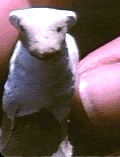 "If, in the course of your world travels, you should happen to spot a tiny, plaster sheep sitting on a bolt in the Eiffel Tower, on top of the Gateway Arch in St. Louis, on the bottom of the Ganges River in India or at hundreds of other famous spots around the globe, take a moment to offer true thanks to the Hartmans' of Burlingame.
"If, in the course of your world travels, you should happen to spot a tiny, plaster sheep sitting on a bolt in the Eiffel Tower, on top of the Gateway Arch in St. Louis, on the bottom of the Ganges River in India or at hundreds of other famous spots around the globe, take a moment to offer true thanks to the Hartmans' of Burlingame.
The family of six, led by their artist dad, James Hartman, began this wacky international sheep phenomenon in 1995. That November, James traveled to Missouri to visit his 84-year-old mother. He helped sort through her boxes of collectable antiques and found one piece that immediately caught his eye: a thumb-sized, finely painted sheep.
"I was struck by it because it had such detail," said James, 49. "Nobody takes the time to do that anymore. They must have used a brush with one bristle." His 10 siblings also admired the little lamb. They wanted James to make a mold of the sheep and give one to each family member. He complied, but didn't stop there.
Eager to find a millennium-themed art project, James truly broke the mold when he declared his goal: Make 2,000 sheep — and hand-paint them all — by 2000. The Hartman family had sheep-painting parties for their friends, forming assembly lines with one person painting the white fleece, another the green grass, another the peach face and legs and another the eyes and smile. They became proficient enough to spend only 10 minutes per sheep.
But the effort wasn't just a local one. They sent kits of 100 sheep and travel-sized shampoo bottles of paint to relatives around the country. They spent their Thanksgivings painting sheep and their Christmases, too. And they surpassed their goal — they painted more than 2,600 sheep.
But the really weird part began when the family started taking small groups of sheep on day trips with them. They photographed herds in Carmel, at the base of Lombard Street in San Francisco and in puddles of water in Mendocino. In 1998, their daughter, Genevieve, took a batch with her on a high school trip to Paris. She and her classmates photographed themselves hiding sheep at the top of the Eiffel Tower, behind a painting at Versailles and in the Louvre (Their teacher hid a sheep in her cleavage, and yes, there's a picture to prove it.)
Soon, friends, friends of friends and even complete strangers wanted to take sheep with them on their vacations. Photos they took of themselves hiding the teeny sheep in various global locations now fill a giant scrapbook at the Hartmans' house. A friend would say, "Oh, I'm going to Croatia" and we'd say, "Take a sheep to Croatia!"
The sheep can now be found on every continent — even Antarctica. They're in a tree in Boca Raton, in a sarcophagus in New York City's Museum of Modern Art, at a fly fishing spot in New Zealand, inside Placido Domingo’s dressing room, at the top of G2 in the Himalayas, at a church in Hawaii, at Albert Einstein's home in Princeton, N. J., in the bedroom of Christopher Columbus' son in the Dominican Republic, in a castle in Wales, in a garden in Luxemburg, at Sydney Harbor in Australia and in the Duomo in Florence.
More sheep can be found in South Africa, Cuba, Vietnam, Fiji, Hong Kong and Brazil. One lucky sheep was even blessed by the Pope. Matthew Siorek, James' nephew, planted 50 sheep around his hometown of Chicago. They can be found in the city’s Picasso Art Institute, behind the center field scoreboard at Wrigley Field, behind the bar at "The Green Mill," a jazz house once owned by Al Capone, and on a plot of farmland where Hartman ancestors settled after moving from Wales.
"It’s all about participation," said Hartman’s wife, Catherine. "Everybody can help. There's a certain type of person who's drawn to creative, fun, adventurous things like this. Each sheep began to take on its own personality, with slightly different facial expressions and slightly different colors. One lamb wears sunglasses and a couple are the "Black sheep of the family." They also have different phrases written on the bottom, including "Meryl Sheep," "Fleece Navidad," "Sheepless in Seattle," "Sheep Car Named Desire," "Ewe Ought To Be In Pictures" and "Nothing Spells Lovin' Like Mutton In The Oven."